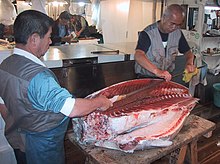Streptococcus iniae
Since its isolation from an Amazon freshwater dolphin in the 1970s, S. iniae has emerged as a leading fish pathogen in aquaculture operations worldwide, resulting in over US$100M in annual losses.Freshwater and saltwater fish including tilapia, red drum, hybrid striped bass, and rainbow trout are among those susceptible to infection by S. iniae.[6] In the 1980s, a purported new species of Streptococcus, named S. shiloi, was identified as one of the causes of an epidemic of meningoencephalitis (an inflammation of the brain and its surrounding membranes) affecting farmed rainbow trout and tilapia in Israel since 1986.Molecular genetics methods, such as DNA sequencing and DNA-DNA hybridization, can be useful for correct identification, although work by the U.S. Centers for Disease Control and Prevention has suggested they are unnecessary in most cases.[27] Fish raised in intensive aquaculture operations and subject to environmental stressors (i.e. suboptimal temperature, poor water quality, crowding, handling, etc.)In tilapia, S. iniae causes meningoencephalitis, with symptoms including lethargy, dorsal rigidity, and erratic swimming behavior; death follows in a matter of days.[38] Human infection with S. iniae was also identified in Toronto between 15 and 20 December 1995, when three Asian patients were admitted to a hospital with cellulitis of the hand after injuring themselves while handling raw fish.[14][26] A subsequent epidemiological investigation found other cases in the Toronto area, for a total of nine patients; all were of Asian descent and all had handled raw fish (mostly tilapia) before developing infection.Enrofloxacin, a quinolone antibiotic, has been used to great effect in hybrid striped bass (Morone chrysops × M. saxatilis), although evidence suggested the development of a resistant strain during this trial.[9][15][27] In the 1995–1996 cluster of human cases, all clinical isolates were susceptible to penicillin, several cephalosporins, clindamycin, erythromycin, and co-trimoxazole (MICs 0.25 μg/ml); all nine patients were treated with parenteral beta-lactam antibiotics and recovered uneventfully.
(left) α-hemolysis; (middle) β-hemolysis; (right) γ-hemolysis (= nonhemolytic)


Phase contrast micrographstreptavidinScientific classificationBacteriaBacillotaBacilliLactobacillalesStreptococcaceaeStreptococcusBinomial nameSynonymsspeciesGram-positivesphere-shapedbacteriumaquaculturetilapiared drumhybrid striped bassrainbow troutmeningoencephalitissepticemiasepsistoxic shock syndromeintervertebral discsinner layer of the heartLancefieldserotypesenzymeantibioticsabscessesAmazon river dolphinbeta-lactam antibioticspenicillintylosinG+C% contentgalactoseDNA-DNA hybridizationjunior synonymPhylogenetic analysesribosomal DNAS. pyogenesS. agalactiaeS. uberisS. canisrestriction fragmentpulsed field gel electrophoresisMolecular geneticsDNA sequencingCenters for Disease Control and PreventionRibotypingrestriction endonucleasesSouthern blottedoligonucleotide probesepidemiologicalconditionsred blood cellsblood agarhemoglobinCAMP-testsodium hippuratebile esculin agarLancefield antigensbiochemical assayarginine dihydrolaseEpizooticsfreshwatereuryhalinecoho salmonJapanese amberjackbarramundiasymptomatic carrierCommon carpchannel catfishgoldfishlethargyexophthalmiaCutaneous Streptococcus iniae infectionopportunistic infectionsimmunocompromisedbacteremiccellulitisendocarditismeningitisosteomyelitisseptic arthritisOttawaTorontoStreptococcus uberisHong KongTaiwanSingaporemortality ratesfish stockprobioticsLactococcus garvieaeAeromonas sobriaEnrofloxacinquinolone antibioticAmoxicillinerythromycinfurazolidoneoxytetracyclineVaccinationcephalosporinsclindamycinco-trimoxazolemacrolidesquinolonesvancomycinBibcodeNew England Journal of MedicineMorbidity and Mortality Weekly ReportGoogle Book SearchWikiVetInfectious diseasesBacterial diseasesoptochinS. pneumoniaePneumococcal infectionViridans streptococciS. mitisS. mutansS. oralisS. sanguinisS. sobrinus